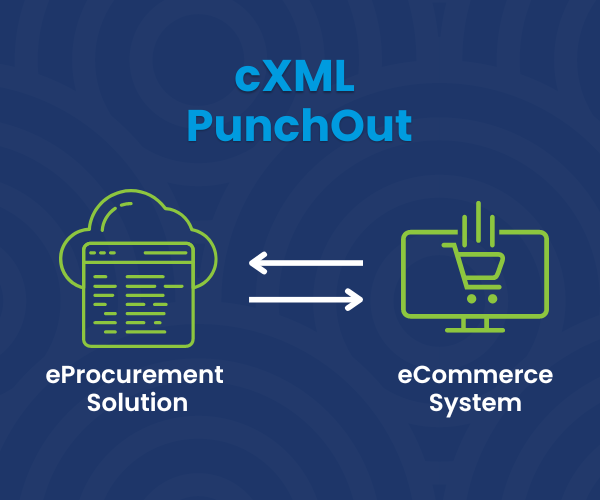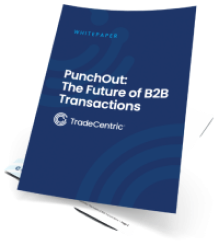Table of Contents
Ever since buyer and supplier systems began communicating with each other in the ’90s, cXML, or commerce extensible markup language, has been one of the main programming languages that make eProcurement possible.
Punchout catalogs use a data format called cXML to integrate a buyer’s procurement system directly with a supplier’s eCommerce site, simplifying the modern B2B buying and selling processes. cXML PunchOut is integral for buyers to shop seamlessly, and not having the integration capabilities will hurt your business sooner than later.
But how does cXML PunchOut work, what happens within the eProcurement system during this process, and what does it look like? The more you know and understand the general XML version and cXML PunchOut process, the more empowered you can be when scaling your own eProcurement system.
How Does cXML PunchOut Work?
The cXML PunchOut process all begins with a PunchOut setup request. A PunchOut setup request is sent from the buyer’s eProcurement system to a PunchOut gateway. This transaction translates the request within the vendor’s system and validates the relevant information such as the user credentials, allowing them to log into the vendor catalog.
From there, customers are able to browse the PunchOut catalogs and build carts that will be sent back through their procurement system and approved to create a requisition order.
Although cXML is used at the beginning of the process during the PunchOut setup request, most of the value between a cXML and PunchOut integration happens during the checkout process. Rather than a traditional checkout process, the shopping cart contents are returned to the customer’s procurement system to go through the approval process.
Once the shopping cart goes through the appropriate approval process, a purchase order is created for the supplier to fill. This is also possible through cXML and PunchOut functionality. In addition, to purchase orders, cXML PunchOut can also help communicate these details between buyers and suppliers:
- Advanced shipping notices
- Invoices
- Other order-related documents and communication

What Happens During the cXML PunchOut Process?
On the back end of the cXML PunchOut process, there are multiple technical steps that happen within every cXML document. Each step is integral to the PunchOut transaction.
PunchOutSetupRequest (POSR) is made – The data within the post often will contain parameters such as unique identifiers that may include the users email address, shipping address, business unit ID, DUNS, and others of which vary from e-procurement systems to system and buyer to buyer that is used by the eCommerce application to properly authenticate the user and reflect the correct offering, pricing, experience, etc.
cXML PunchOut Example
Below is a real-world example of what this information looks like in a doctype cXML system. This cXML example represents a PunchOut Setup Request, which is sent from a buyer’s eProcurement system to a supplier’s eCommerce platform to initiate a session. It includes user identification, session tracking (via a buyer cookie), and a redirect URL that begins the PunchOut shopping experience.
Below are examples of the data points that would be used in the PunchOut Setup Request:
- FirstName: John
- Last Name: Doe
- UniqueName: BUZf6d8
- User Email: [email protected]
- User: BUZf6d8
- Business Unit: 13843
- Contact: email: [email protected]
- Name: BUZf6d8
- Unique: BUZf6d8
- Buyer cookie: 7555371f46f7a5d057ac3567a2df12c2
- postform: https://acme_buyer.coupahost.com/punchout/checkout?id=1
And this is how those data points would be presented in cXML:
<Sender>
<Credential domain=”NetworkID”>
<Identity>BUZf6d8</Identity>
<SharedSecret>mySharedSecret</SharedSecret>
</Credential>
<UserAgent>TradeCentric PunchOut</UserAgent>
</Sender>
</Header>
<Request deploymentMode=”production”>
<PunchOutSetupRequest operation=”create”>
<BuyerCookie>7555371f46f7a5d057ac3567a2df12c2</BuyerCookie>
<BrowserFormPost>
<URL>https://acme_buyer.coupahost.com/punchout/checkout?id=1</URL>
</BrowserFormPost>
<Contact>
<Name xml:lang=”en”>John Doe</Name>
<Email>[email protected]</Email>
</Contact>
<Extrinsic name=”User”>BUZf6d8</Extrinsic>
<Extrinsic name=”UniqueName”>BUZf6d8</Extrinsic>
<Extrinsic
Need a PunchOut Catalog Solution?
What are the Benefits of cXML and PunchOut Integration?
We’ve talked about how the integration between commerce XML and a PunchOut catalog is integral to making a seamless connection between a buyer’s procurement system and a supplier’s eCommerce site. But transferring data between eProcurement applications and choosing cXML PunchOut also has additional benefits for both the buyer and the supplier.
Benefits for Suppliers
Using a computer language like cXML in PunchOut enables seamless and automated communication between a buyer’s eProcurement system and a supplier’s eCommerce site. It standardizes how data such as product details, pricing, and cart information is exchanged. This leads to:
Accelerated time-to-revenue: Orders come in ready for fulfillment, shortening sales and payment cycles.
- Improved buyer satisfaction: A smooth PunchOut experience makes it easier for buyers to re-order.
- Streamlined order intake: Reduces manual processing by automating PO transmission and confirmation.
- Fewer support tickets and order issues: Data accuracy and automated processing reduce customer service overhead.
- Greater visibility into order status: Suppliers can update order status in real-time, improving transparency.
- Stronger retention and renewal: A connected commerce experience builds long-term buyer loyalty.
Benefits for Buyers
For buyers, using a computer language like cXML in PunchOut simplifies and streamlines the buying process to make enterprise purchasing more efficient and compliant. It allows their eProcurement system to connect directly with a supplier’s online catalog, enabling real-time product selection, pricing, and cart transfer without manual entry.
- Faster order processing: Orders are placed directly through the eProcurement system, speeding up approvals and fulfillment.
- Streamlined workflows: Automated routing, approvals, and PO generation reduces manual bottlenecks.
- Improved purchasing compliance: Ensures that buyers adhere to contracted pricing and preferred suppliers.
- Accurate, real-time product data: Access live catalog data, including current pricing, inventory, and specs.
- Enhanced visibility and control: Procurement has full oversight of spend, orders, and vendor performance.
- Reduced manual entry and errors: Eliminates data re-entry between systems, minimizing costly mistakes.
- Seamless user experience: Teams can browse supplier catalogs without leaving their own procurement platform.
Ready to experience the benefits of cXML?
cXML PunchOut: Next Steps
Whether you need a complete overhaul of your procurement system, a better way to integrate PunchOut catalogs, or a more efficient way to create purchase orders, TradeCentric can answer all of the questions you may have about the doctype cXML system and how to properly integrate with a PunchOut catalog to achieve the best results for your business continuity.
WHITEPAPER
Connect eCommerce systems with eProcurement solutions to enable seamless purchasing
Download




